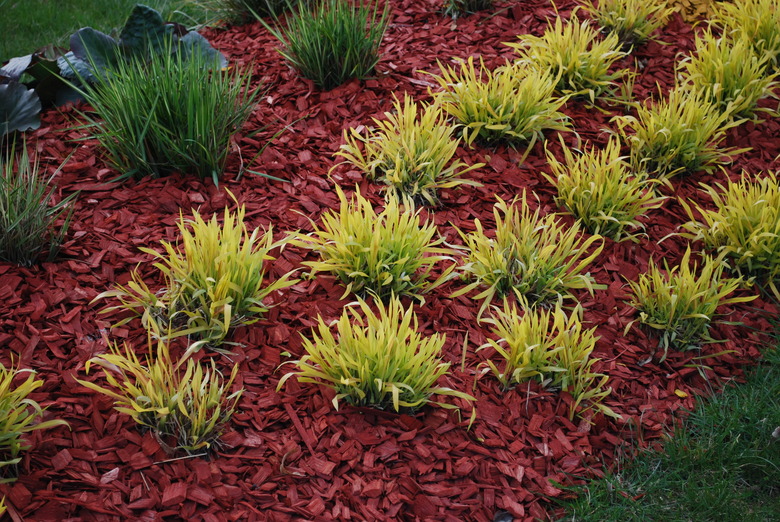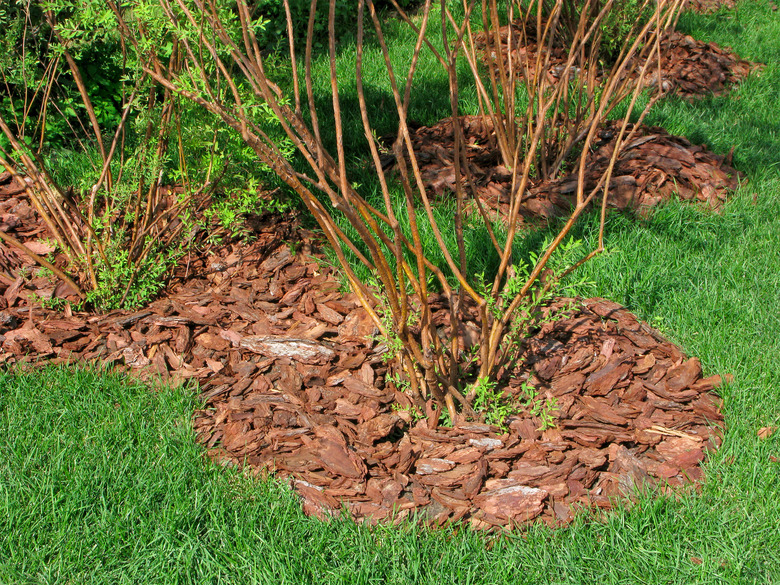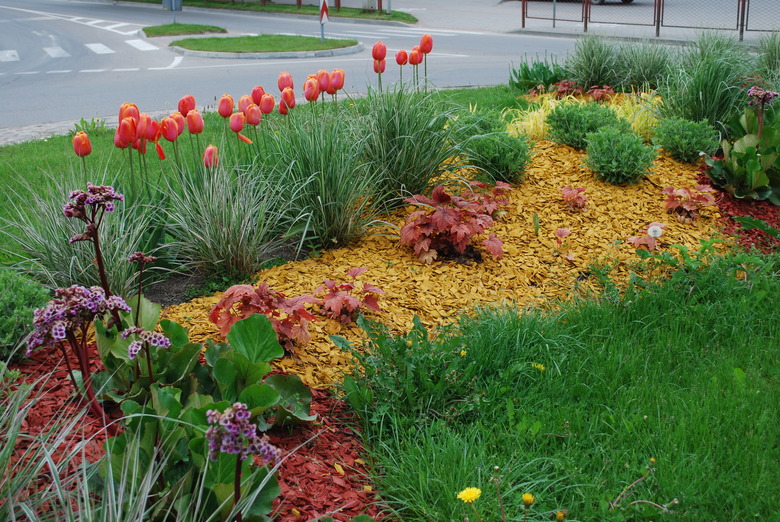A DIY Guide To Mulching In Your Landscape
We may receive a commission on purchases made from links.
As any hardcore gardener can attest, mulching is as much an art as a science. You can choose from a wide variety of mulch materials, colors and sizes, creating the look you want while making sure your plants' needs are met. You can also think outside the box (or flower bed) and get creative with your mulching, using mulch to create meandering paths through your garden or to add a nice focal point around your mailbox. There are many different mulches from which to choose, but you'll sort through them with ease once you understand a few mulching basics.
Benefits of Mulching
Benefits of Mulching
A nice layer of mulch around your plants absolutely makes your garden look a bit nicer. It can also add color and texture to your gardening space, adding another layer of visual interest. But besides looking great, mulching has several more utilitarian benefits as well.
One major benefit is that it slows weed growth. Mulching won't stop weeds entirely, but it greatly reduces their number. Fewer weeds means less pulling and spraying for you. Mulch also reduces the time you spend watering your plants. Why exactly? Water easily passes through properly applied mulch, settling into the soil below. Once it's there, the mulch acts as a barrier between the sun and the soil, slowing the water's evaporation.
In addition to protecting plants from evaporation that could dry their roots, mulch also insulates roots to protect them from extreme heat and cold. Mulched flower beds are far more likely to survive a late-season cold snap than bare beds.
Over time, you'll find that mulching can greatly improve the quality of your soil if you choose an organic mulch, which will decompose over time. As it does, nutrients in the mulch become part of the soil underneath, making it richer.
Types of Mulch
Types of Mulch
There are two main mulch types: organic and inorganic. Organic mulch, as its name suggests, is a type of mulch made from organic materials, such as wood chips. Inorganic mulch is usually made of rubber. Some people also use stones, plastic sheeting or landscape fabric as inorganic mulch.
Organic mulch works best when you wish to slowly improve poor soil and don't mind adding more mulch to your beds each spring. It makes a muddy mess, however, in low-lying areas and spots that are prone to flooding and puddles. In these areas, inorganic mulch works much better.
Inorganic mulch can also save you the hassle of mulching every spring, as it stays in place much longer. It will eventually decompose if it's made of rubber, but it takes much longer to do so. Note, however, that rubber mulch may contain unwanted chemicals. Think twice before spreading it in the garden if you're growing your own fruits and vegetables.
Organic and inorganic mulch are the two main mulch categories, but there are lots of options within each group. You can use a large array of organic materials for mulch, including compost, straw, grass clippings, shredded leaves or wood chips. You can even find organic mulch colored with vegetable dyes to create an interesting color palette. Inorganic mulch made from rubber comes in many colors, as do stone and gravel.
The Landscape Fabric Debate
The Landscape Fabric Debate
When shopping for mulch, you will inevitably come across plastic sheeting and landscape fabric. Gardeners sometimes lay these materials underneath their mulch to help prevent weeds. This is somewhat helpful if you're using inorganic mulch, as it helps keep the mulch from sinking into the earth. It's a nuisance with organic mulches, however, as the plastic or fabric can prevent the decomposing mulch from reaching and enriching the soil.
Gardeners can't seem to agree on whether or not plastic sheets and landscape fabric really help with weed suppression. They agree, however, that these materials are an eyesore when they poke out from under your mulch, and eventually, they will. Over time, plastic sheeting and landscape fabric tear and break down, peeking out from beneath your plants.
Sales clerks at garden centers tend to oversell the weed-prevention properties of these materials while downplaying how tatty they can look a year or two down the road. Generally, it's best to avoid plastic and landscape fabric when using it underneath a garden.
Mulch Selection Tips
Mulch Selection Tips
When choosing your mulch, there are a few tips to keep in mind. One is being mindful of mulch size. Mulches made with large wood chips decompose a bit more slowly than finer mulches, but large wood chunks can overwhelm small, delicate plants. Choose large, chunky mulches only when mulching around large plants, like trees and shrubs.
Choose your mulch dealer carefully as well. If you need only a few bags of mulch, you can easily grab some at your local home center or hardware store. When mulching large areas, however, it's best to visit a garden or landscape center that can deliver a truckload to you. Look over the mulch carefully and buy only from reputable sources. A bad batch of mulch that contains insect larvae or weed seeds can wreak havoc on your garden.
When mulching next to walkways, patios or driveways, use dyed mulches carefully. Hard rain and heavy irrigation can wash away some of the dye and transfer it to your walk or patio. You can minimize the risk of dye stains by waiting 24 to 48 hours to water your plants after you mulch and by watering only during very dry weather.
If you choose dyed mulch, Dalman's Evergreens claims that you should expect the color to fade after one growing season. Very dark colors, however, may take a bit longer to fade. Once they do, you'll have to live with the faded color or mulch again.
In some areas, you may see cocoa bean mulch for sale. Cocoa bean mulch is an attractive, rich-brown color and smells heavenly. Cocoa mulch applied more than an inch thick is prone to molding, however, and the mulch could harm dogs if they ingest or chew it. Cocoa bean mulch also blows away when allowed to dry out, so you may need to replace it frequently. Some gardeners feel the delightful chocolate smell is well worth the extra effort, though.
How Much Mulch?
How Much Mulch?
To determine how much mulch you need, you first need to know how deep you want your mulch to be. At a minimum, you'll want your mulch to be 2 to 3 inches deep. If you're using a very coarse mulch like pine bark nuggets, you can go 4 inches deep.
Next, you need to know the square footage of your garden. To find it for a square or rectangular bed, measure the length and width of your flower bed and then multiply the two numbers. If you have a round bed, measure it from the center out and then take the number times 3.14. (You might recognize this number as pi from your geometry class back in high school.)
You now know how many square feet of area you need your mulch to cover. Unfortunately, mulch is usually sold by the cubic yard, so there is more math ahead. According to Country Living, the formula you need to account for this becomes square footage times desired mulch depth in inches. This number is then divided by 324 to arrive at the number of cubic yards of mulch you need.
Say, for example, that the flower bed in your lawn is 10 feet long and 20 feet wide. You need to cover 200 square feet (20 x 10 = 200). If you plan to mulch 3 inches deep, you'll need almost 2 cubic yards of mulch (200 x 3 / 324 = 1.85).
Don't worry if all this math makes you scratch your head—there are tons of free mulch calculators available online that will do the heavy lifting for you.
How to Mulch
How to Mulch
Now that you know why you should mulch and what to mulch with, it's time to actually get the job done. Your first step is to thoroughly weed your garden. Mulch can help prevent weeds but won't choke out any that have already established themselves. If the weeds in your garden were numerous and vigorous, consider laying sheets of newspaper over the areas you plan to mulch. This will help to further suppress weeds with a safe material that will decompose over time. Just be aware that newspaper ink may not be organic; this is a consideration for organic gardens.
When you're ready, begin spreading your mulch to the desired thickness with your hands or a garden rake. Leave a gap of several inches between the mulch and plant stems or tree trunks. This gap prevents the mulch from holding too much water against the plant stems, potentially rotting them. Mulch piled against a tree trunk also makes a great nest for rodents and insects that could damage the plant.
If desired, install garden borders or edging along the perimeter of mulched beds to keep the mulch in place. Lightly water your newly mulched flower beds within 24 to 48 hours of spreading the mulch.
Make Your Own Mulch
Make Your Own Mulch
If you're mulching on a budget or feeling particularly earthy, you can always try your hand at making your own mulch. To do so, begin by raking your leaves into small piles. Once you have, set your lawnmower to mulch if you can and mow over the leaf piles. If necessary, rake the leaf bits up and mow them again, repeating the process until the leaf bits are about the size of dimes.
You can use the shredded leaves alone as mulch. If, however, you have any fallen tree limbs or need to do any pruning, you can add wood to your mulch. To do so, rent a wood chipper and run the tree limbs through it. You can then mix the wood chips into your leaves with a shovel or pitchfork for a somewhat longer-lasting organic mulch.
Admittedly, homemade mulch isn't quite as pretty as the mulch you get at the garden center, but it's effective and gets the job done. If curb appeal is a concern, you can still save money by using commercial mulch in your front lawn and homemade mulch in vegetable gardens or around backyard plantings that only you see.


